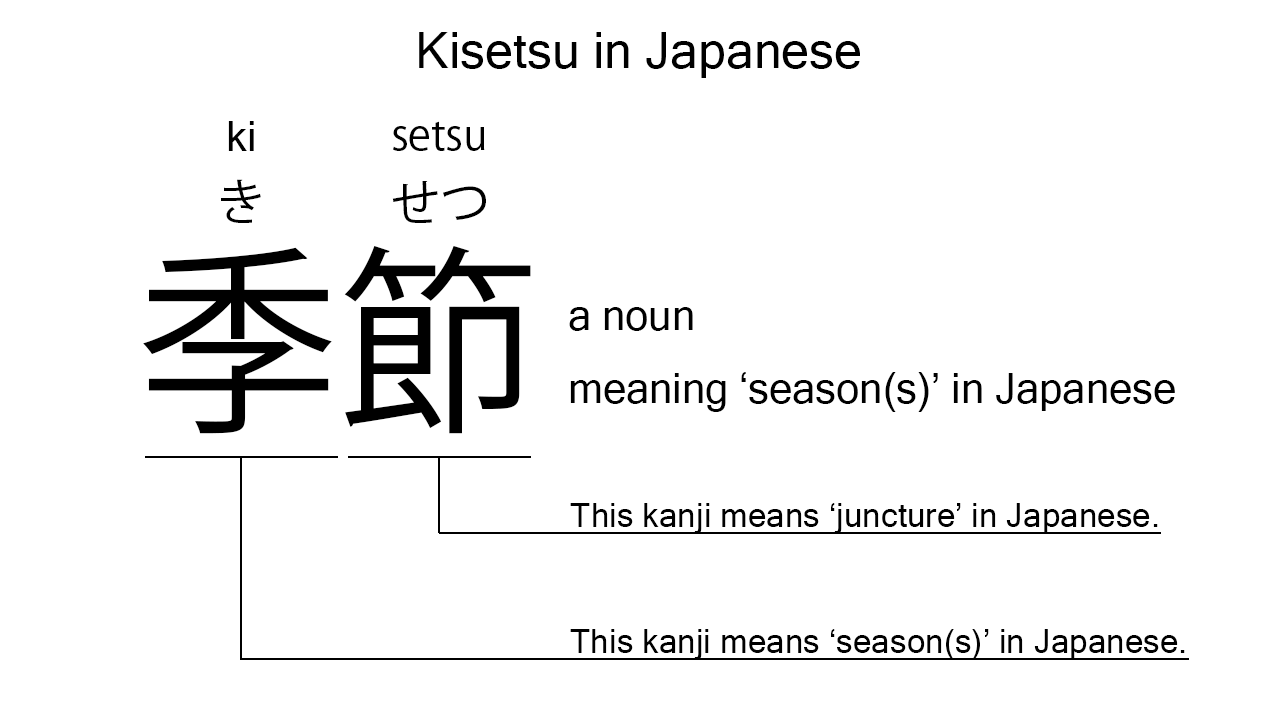What does “kisetsu” mean in Japanese?
Native speakers say “kisetsu” to mean ‘season’ in Japanese. Perhaps, some Japanese learners know this word as it is sometimes used in Japanese conversations. In this blog post, however, I will explain this word in detail based on its kanji expression. And also, I will explain how to use it through example sentences. My explanations would help Japanese learners to understand “kisetsu” more clearly. Then, let’s get started!
Contents
Definition and meaning of “kisetsu”
Let me start with the definition and meaning of “kisetsu”.
- kisetsu – 季節 (きせつ) : a noun meaning ‘season’ in Japanese. This can also work as plural. Learn more about Japanese plural.
Normally, native speakers use this noun to refer to one of the four periods of the year. So, its role is very similar to that of the English noun, “season”.
The definition and meaning are very simple and clear, I think. To understand this noun more clearly, however, let me explain its kanji characters in detail, one by one.
Kisetsu in kanji
The kanji expression of “kisetsu” consists of the following two characters:
- 季 : a kanji character widely used to mean ‘season’ in Japanese.
- 節 : a kanji character used to mean ‘juncture’ in Japanese.
These two kanji characters tell us that “kisetsu” literally means a season and juncture in Japanese. This literal interpretation seems to be very close to the actual meaning.

When we meet new kanji expressions, we should check their kanji characters in detail to understand their meanings clearly and deeply. In many cases, kanji characters tell us a lot about the meanings of the expressions they form. Actually, here, we could get the better understanding of “kisetsu” through the detailed check above.
So far, I’ve explained the definition and meaning of “kisetsu” together with its kanji expression. Then, let me explain how to use it through the example sentences below.
Example #1: how to say “season” in Japanese
watashi wa kono kisetsu ga suki desu – 私はこの季節が好きです (わたしはこのきせつがすきです)
I love this season.
Below are the new words used in the example sentence.
- watashi – 私 (わたし) : a pronoun meaning ‘I’ in Japanese.
- wa – は : a binding particle working as a case marker or topic marker. In the example, this works after “watashi” to make the subject in the sentence.
- kono – この : a determiner used before a noun referring to a thing close to the speaker. In the example, this is used before “kisetsu” to say “this season” in Japanese.
- ga – が : a case particle used to make the subject word or the object word in a sentence. In the example, this is used after “kono kisetsu” to make the object in the sentence.
- suki – 好き (すき) : the stem part of the na-adjective, “sukina”, which means ‘favorite’ in Japanese. Native speakers, however, quite often use this as an individual word to mean ‘to like’ or ‘to love’ in Japanese. In the example, actually, this is used to mean ‘to love’.
- desu – です : an auxiliary verb used after a noun or adjective to make it polite. Probably, this is well known as a part of Japanese desu form. In the example, this is used after “suki” to make it sound polite.
This is a typical usage of “kisetsu”. In this example, it works together with the determiner, “kono”, to say “this season” in Japanese.
Example #2: another usage of “kisetsu”
kisetsu ga natsu kara aki e kawaru – 季節が夏から秋へ変わる (きせつがなつからあきへかわる)
The season changes from summer to autumn.
Below are the new words used in the example sentence.
- natsu – 夏 (なつ) : a noun meaning ‘summer’ in Japanese.
- kara – から : a case particle used to refer to a starting point. In the example, this is used after “natsu” to indicate the starting point of the change.
- aki – 秋 (あき) : a noun meaning ‘autumn’ in Japanese.
- e – へ : a case particle used to refer to an ending point. In the example, this is used after “aki” to indicate the ending point of the change.
- kawaru – 変わる (かわる) : a verb meaning ‘to change’ or such in Japanese.
This is another typical usage of “kisetsu”. When we want to say “season” or “seasons” in Japanese, this noun is always a very good option.
Summary
In this blog post, I’ve explained the definition and meaning of “kisetsu” in detail based on its kanji expression. And also, I’ve explained how to use it through the example sentences. Let me summarize them as follows.
- kisetsu – 季節 (きせつ) : a noun meaning ‘season’ in Japanese. This can also work as plural. These two kanji characters literally mean a season and juncture in Japanese. This literal interpretation seems to be very close to the actual meaning. When we want to say “season” or “seasons” in Japanese, this noun is always a very good option.
Hope my explanations are understandable and helpful for Japanese learners.
Leave a Reply